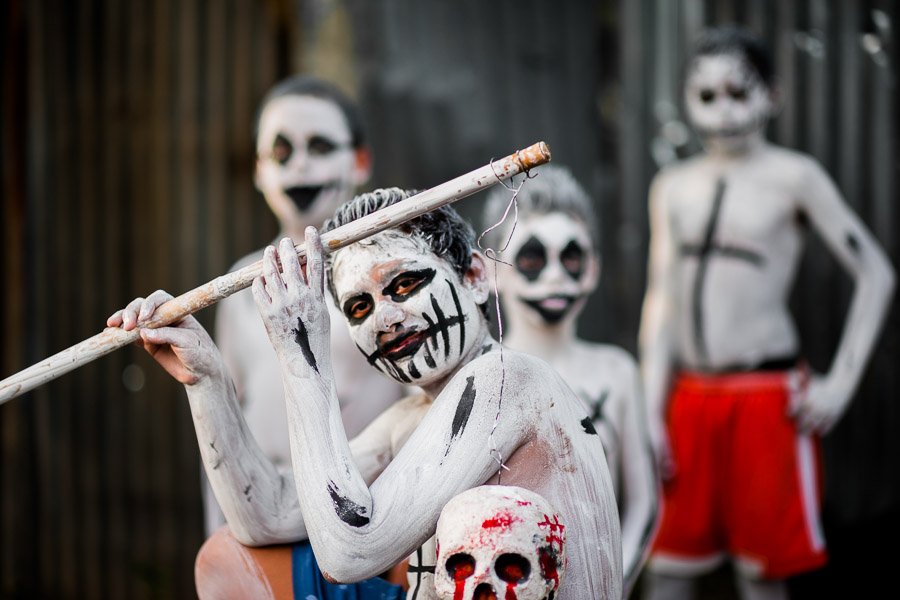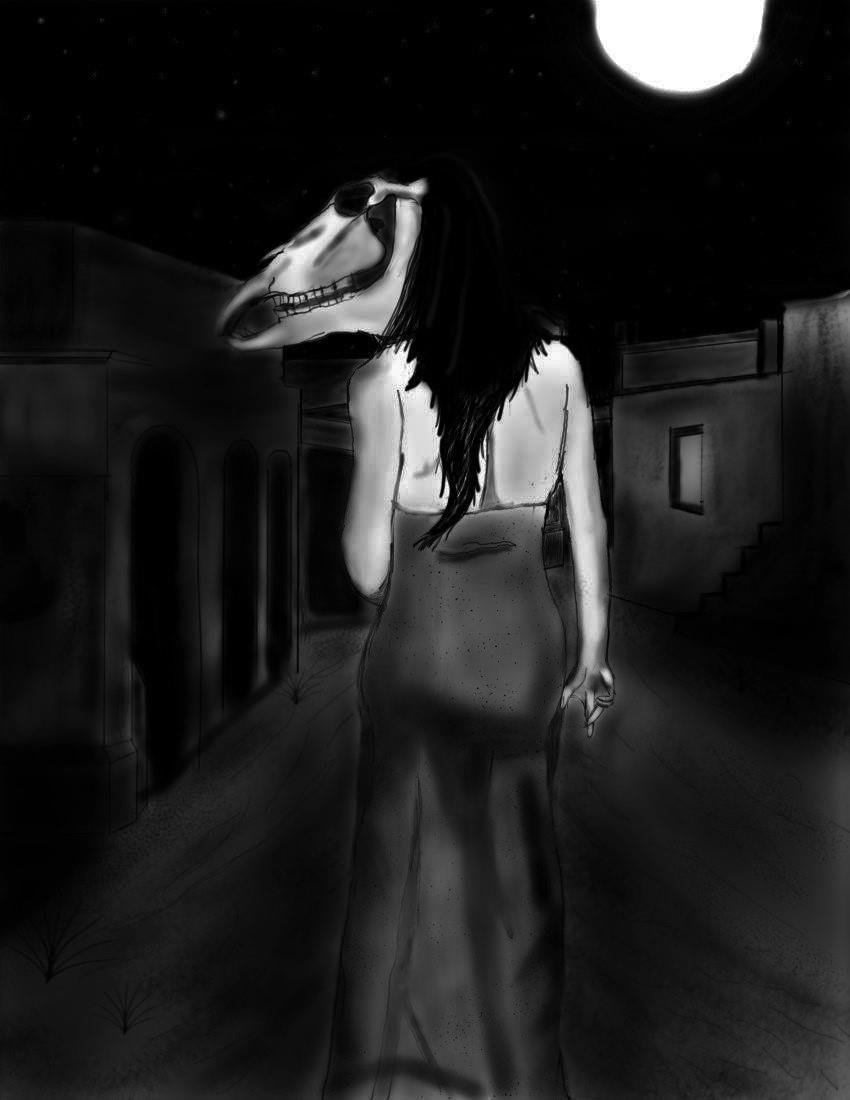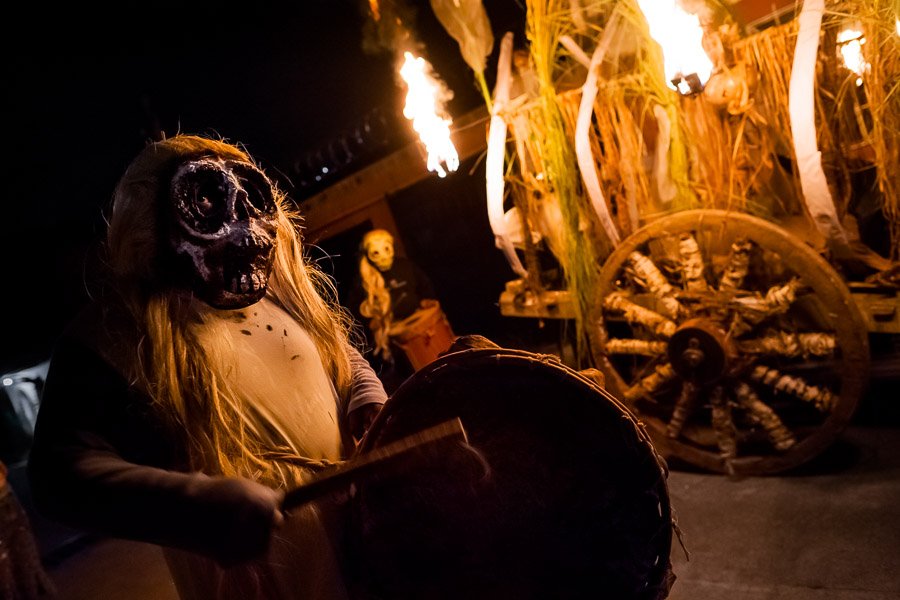Spooky Central America
By Jonathan Peraza Campos
Salvadoran boys, wearing white body paint with death symbols, perform during the La Calabiuza parade at the Day of the Dead festivity in Tonacatepeque, El Salvador. © Jan Sochor photography
I’m a huge fan of Halloween, horror movies and stories, ghost stories, and folklore. Traditional folklore from Central American countries tells us about ghosts and monsters that permeate Central American consciousness. Engaging with folklore is a culturally responsive teaching tool to help students understand stories from their heritage countries. However, folklore and horror are more than just tales of terror and speculation meant to make us jump. Many of our ghost and horror stories have sociopolitical themes. In fact, horror has always been political.
Below, find resources to learn about about festivities in Central America, as well as regional ghost and monster stories. What social and political themes emerge in these stories?
Ghost and Monster Stories
La Llorona
Jayro Bustamente’s 2019 film, La Llorona, situates the well-known Latin American tale of la llorona, the weeping woman who is in search of her dead children, within Guatemala’s horrific history of civil war and Indigenous genocide. Foreign Policy and Salvadoran-Belgian journalist Melissa Vida at Global Voices provide analyses of the image and story of la llorona in Latin American horror, namely Bustamante's film. In the film, a former Ladino Guatemalan general and dictator who is being tried for the genocide of Maya peoples in the country is haunted by the ghosts of his crimes against humanity. He and his family are enduring the rage of the Guatemalan peoples who protest day and night outside of his home. At the same time, after a young Mayan woman joins his house’s service staff, spooky events begin to haunt him and his family. Human rights defender and Mayan activist Rigoberta Menchú makes an appearance during the trial. This film can be used to engage students in discussions about the Indigenous roots of much of Latin American folklore, the atrocities of Central American armed conflicts, anti-Indigenous violence, and social movement resistance.
Xtabai
Other popular tales in Central America related to la llorona are the Belizean Mayan folklore of Xtabai, who seduces tourists and men in her form as a beautiful woman, lulling them into an eternal sleep or having them wake up stuck to a thorny ceiba tree. In other renditions, she kills them or makes them sick.
La Siguanaba
By SmokeBoats
In the story of la siguanaba of El Salvador (also known as la Cegua in other parts of Central America), the ghost woman is said to appear to drunk and abusive men as a beautiful temptress in the evening, ultimately appearing to them in her ugly, sometimes horsehead, state. The men are stunned, stupefied, or disappear completely after an encounter with her. The podcast Espooky Tales talks about the siguanaba legend and cites eyewitness accounts along with its Indigenous mythological roots.
La siguanaba is a great story to discuss alongside more critical pieces that provide a feminist analysis of the ghost woman. Salvadoran American poet Janel Pineda touches on themes of womanhood and patriarchal violence in her poem “When the Men Come Looking” in her book Lineage of Rain where she imagines herself taking the form of la siguanaba to protect herself from patriarchal violence. The essay by Karina Alvarado, “A Gynealogy of Cigua Resistance” in the anthology U.S. Central Americans, discusses the Indigenous roots of the siguanaba story, as well as feminist Salvadoran women whose legacies are part of a lineage of subversive women like la siguanaba. Read more at Chalatenango SV.
El Cadejo
A ghost or demon dog of mythic proportions – one black and one white – one representing evil and the other more inclined to protect people. When teaching this story, though, we should engage our students in the problematic notion of “whiteness” as good and “blackness” as bad that is largely rooted in European notions of race and difference. Learn more about el cadejo at Espooky Tales. The children’s book, Magic Dogs by Manlio Argueta, tells a rendition of the cadejo story appropriate for elementary-age students.
El Cipitio
The cipitio is a ghost that takes the form of a boy child and is the son of la siguanaba. He is known to be a trickster who eats ash below people’s houses and can teleport from place to place. He has a habit of pursuing young girls. Learn more at Espooky Tales.
El Sombrerón
Based in Guatemala, the tale of el sombrerón represents a short boy, or even a goblin, who wears a large hat, dons braids, and often pursues young women. He is known to eat dirt and serenade the girls he is trying to seduce. Learn more at Remezcla.
Duende/Tata Duende
Another popular tale throughout Latin America, including Central American countries, is the story of el duende, or Tata Duende. It is a goblin or elf-like creature known to be mischievous or a trickster or in other renditions, a defender of children and nature. Iberian settlers brought tales of elves (“duendes”) over to the Americas but in Mayan and Indigenous folklore, a spirit resembling a short man with a large hat was believed to patrol and protect forests. This entity is sometimes referred to as or conflated with an Alux in Mayan folklore, a mischievous nature spirit and protector.
Day of the Dead and La Calabiuza
While Halloween is a commercialized U.S. festivity with roots in European pagan traditions, the Day of the Dead (Dia de los muertos/Dia de los Difuntos) in parts of Central America is a tradition rooted in ancestral remembrance.
Between October and November, Central Americans honor their ancestors by building altars, decorating graves, and participating in mestizo and Indigenous rituals to connect with their ancestors. In Guatemala, some build colorful kites to commemorate their dead, while in El Salvador, others convene with their ancestors by decorating graves and spending time at the graves of their loved ones in joyful celebration. Teachers can find lesson plans about Dia de los Muertos/Difuntos at Vanderbilt University’s Center for Latin American Studies.
In El Salvador, the town of Tonacatepeque celebrates la Calabiuza on November 1st, where they dress up as notable ghosts and monsters in El Salvador’s folklore to celebrate the country.
Further Reading
In El Salvador, citizens reject Halloween and celebrate a unique Day of the Dead — An English language article from the Tico Times recounts the Salvadoran festival of la Calabiuza that honors Salvadoran folklore and the dead as a contrast to U.S. Halloween.
Vista de Festival de la Calabiuza — A Spanish language article from the Balajú magazine about the Calabiuza festival in Tonacatepeque that precedes the day of remembrance for the dead.
Take A Look At El Salvador’s Anti-Halloween Festival, Where People Pay Tribute to Indigenous Folklore — MiTu’s article about El Salvador’s La Calabiuza festival.
Jan Sochor Photography — Jan Sochor’s photography of La Calabiuza.
A Salvadoran man, wearing a skull mask, plays drum during the La Calabiuza parade at the Day of the Dead celebration in Tonacatepeque, El Salvador. © Jan Sochor photography




